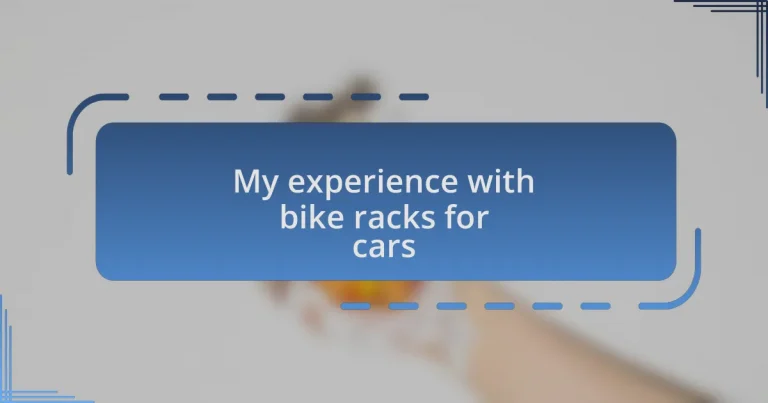Key takeaways:
- Different types of bike racks (hitch-mounted, trunk-mounted, roof-mounted) affect vehicle performance and cycling experience.
- Compatibility between the bike rack and both the vehicle and bike type is crucial for optimal use.
- Investing in a durable and rugged bike rack enhances enjoyment during outdoor excursions and minimizes worries about equipment failure.
- Properly securing bikes and considering their positioning on the rack are essential to prevent damage during transport.
Author: Olivia Hartwell
Bio: Olivia Hartwell is a contemporary fiction author known for her compelling narratives and vivid characterizations. With a background in literature and creative writing, she has a keen eye for detail and a passion for exploring the complexities of human relationships. Olivia’s debut novel, Whispers of the Heart, received critical acclaim and was nominated for several literary awards. When she’s not writing, she enjoys hiking in the mountains of Colorado and sipping artisanal coffee at local cafes. Olivia resides in Denver with her beloved rescue dog, Rosie.
Understanding bike racks for cars
When I first started using bike racks for my car, I was genuinely surprised by how many options there were. There are hitch-mounted, trunk-mounted, and roof-mounted racks, each with different features and benefits. Have you ever considered how the type of rack you choose can affect your cycling experience?
For instance, I remember my first road trip with a trunk-mounted rack. It felt great to hit the road with my bike securely attached, and the ease of loading and unloading made me appreciate the convenience it offered. However, I quickly realized that the extra weight sometimes affected my car’s handling, raising the question: how much are you willing to compromise on performance for the sake of portability?
As I navigated the world of bike racks, I learned the importance of compatibility with both my car and bike. Did you know that some racks are designed for specific bike styles? When I discovered this factor, it reshaped my understanding of how to choose the right rack. I felt a sense of relief knowing that I could make a choice that enhanced not just my car’s performance but also my biking adventures.
Benefits of using bike racks
Using bike racks comes with a multitude of benefits that can enhance your cycling experience. For example, I remember the first time I loaded my bike onto a hitch-mounted rack; the stability it provided made me feel confident that my bike was secure for those long drives. It’s amazing how a sturdy bike rack can alleviate worries about damage or loss, transforming my road trips into purely enjoyable adventures.
One of the greatest advantages I’ve found is the ability to travel with friends. When my biking buddies and I decided to head out for a weekend cycling retreat, the trunk-mounted rack allowed us to transport multiple bikes at once effortlessly. It struck me how easily we could unite our passions for both travel and cycling, sharing valuable moments together while exploring new trails.
The convenience of bike racks also extends to city life. Living in an urban area, I often find it daunting to navigate public transport with my bike. I vividly recall a rainy day when I chose to use my roof-mounted rack instead of risking the bus. That experience opened my eyes to how bike racks not only promise to make transportation easier but also encourage spontaneity, allowing you to seize opportunities for cycling adventures on the fly. Isn’t it liberating to have the freedom to explore new places?
Choosing the right bike rack
When selecting a bike rack, consider your vehicle type and how many bikes you plan to carry. I remember the moment I realized just how vital this choice was; the first time I tried to fit a four-bike rack onto my compact car, it became painfully clear that not every rack suits every vehicle. Did I really think I could lug around that much gear without checking compatibility first?
Another important factor is the rack’s mounting style. I’ve had my fair share of experiences with both trunk-mounted and hitch-mounted racks. It was a game changer when I switched to a hitch-mounted option for long trips; the ease of loading and unloading is unmatched. I still find myself smiling when I think about how much less struggle I face now compared to those early days of wrestling with a trunk rack.
Lastly, materials and durability should never be overlooked. After investing in a rugged, corrosion-resistant bike rack, I was surprised at how much more I enjoyed my outdoor excursions. I vividly recall one rainy weekend, knowing that my bike rack wouldn’t succumb to the elements made all the difference, allowing me to focus on the ride ahead rather than worrying about equipment failure. So, is it worth investing a bit more in quality? Absolutely.
Tips for using bike racks
When it comes to using bike racks, securing your bikes properly is crucial to avoid any mishaps on the road. I remember one particularly adventurous trip where I neglected to double-check the straps on a popular day at the park. Halfway there, I caught that eerie silence where wheels should have been spinning, only to realize my bike had nearly slipped off the rack. That moment taught me the value of thorough checks before hitting the road.
It’s also essential to be mindful of your bike’s position on the rack. On one occasion, I loaded my mountain bike in a way that the handlebars clashed with the frame of my partner’s road bike. It was a tight squeeze that resulted in a scratched up frame and a lesson learned. Always consider the shape and size of each bike when loading them; not only will it save you from damage, but it will also make unloading much smoother.
Lastly, be cautious of the height clearance when driving. I learned this the hard way while navigating a parking garage with my bikes on the roof rack. As I zoomed in, I suddenly felt my heart drop as my bike rack scraped the ceiling. Now, I always make a habit of checking the maximum height signs before entering. It might seem trivial, but it can prevent a costly mistake—and an embarrassing one at that!


